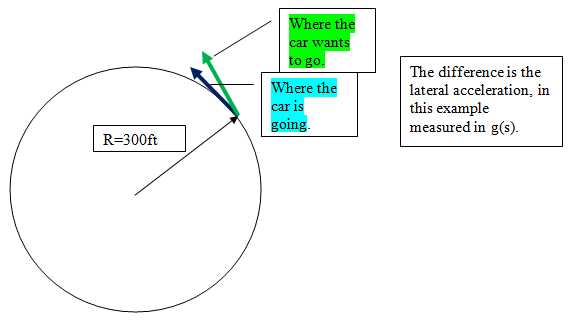How fast can you go – in a circle?
Before answering the question, let us discuss why you may want to answer the question. There are two important things that can be learned from driving a circle to the limit of your car. When you reach the limit of adhesion (traction) of the tires, one of three things will occur: 1) the back end looses traction before the front (over-steer), 2) the front end looses traction before the rear (under-steer), or, 3) both ends loose traction at the same time and the car moves toward a larger radius in a even fashion (neutral). Neutral is desired in most cases, drifting being a noted exception where over-steer is a desired trait. The second thing you can learn is how will does your car stick in a corner in terms of g force, a common measure of lateral acceleration. So, how big of a circle do you need and how do you measure the g force?
Fortunately there is some math for that: V^2/15*R=g. Where V is the speed of the car in mph; R is the radius of the skid pad; g is the lateral force against the car. For example: if your car could obtain 60mph on a 300ft radius before either end reaches their limit of adhesion, you would have obtained 0.8g of lateral force.
If you want to design a skip pad, what should the radius be? First answer two questions. One, what is a safe speed given the skip pad environment? Two, what is the estimated g force for the cars that will be testing. General rule of thumb: street tires .7g, performance tires .8g, race tires 1.0g. This is very general and has not taken into account the type of suspension systems the cars will have. Given these two values, solve for R.
R= V^2/15*g
Lastly, what do you do if the cars do not have a speedometer? You have to know the car speed at the point one or both ends loose traction. Time the car with a stopwatch and use the following formula.
MPH = (C/5,280)/(S/3,600)
Where C = circumference = R(in ft)*2*3.14; S = seconds per complete circle.
While performing the skip pad runs, be careful not to create throttle induced over-steer or under-steer. Accelerating to quickly may cause the rear end to let go because you are using too much of the drive tires for acceleration as opposed to lateral (sideways) control. The same can happen with lifting your foot from the throttle to quickly, because the drive tires are being used for braking (engine braking).
Of course, all this is just the beginning. What should you do if the car is “loose”, rear end leaves the circle before the front (over-steer), or “tight”, front end pushes off the circle before the rear (under-steer)? Now, you have to go back to the shop, change springs and/or sway bars, but that is the subject of another article.






